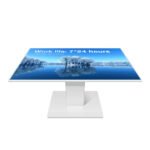Why Choose an LCD Screen Display for Digital Signage?
The modern marketplace is increasingly visual, and digital signage stands at the forefront of this evolution, transforming public spaces, retail environments, and corporate communication. At the heart of virtually every successful digital signage deployment lies a robust and reliable lcd screen display. For businesses considering an investment in dynamic visual communication, understanding the foundational technology—specifically the capabilities and advantages of the Liquid Crystal Display (LCD)—is not merely helpful; it is absolutely crucial for making an informed, long-term decision. This in-depth guide is tailored for digital signage product users, aiming to provide substantial, actionable insight into why LCD technology remains the workhorse of the industry, offering unparalleled balance in performance, cost, and versatility.
The Foundation: Understanding the LCD Screen Display Technology

An lcd screen display functions by utilizing the light-modulating properties of liquid crystals. Unlike emissive displays (such as OLEDs) that generate their own light, an LCD relies on a separate backlight—typically a set of LEDs—to illuminate the image. This fundamental difference is key to many of the technology’s strengths in the commercial signage sector. The process involves precisely controlling the alignment of liquid crystals to either allow the light to pass through color filters or to block it, thereby creating the vibrant images and detailed text that captivate audiences.
It is this robust structure that makes LCDs highly effective for commercial applications. Furthermore, the consistent nature of the LED backlight ensures uniform brightness across the entire panel, which is vital when attempting to capture attention in varied lighting conditions, from the shaded corner of a mall to a brightly lit airport terminal. The technology is stable and has been refined over decades, meaning that digital signage solutions built around LCD panels are inherently reliable and predictable in their long-term performance.
Essential Features and Advantages for Digital Signage Applications

In the demanding realm of 24/7 or 16/7 commercial operation, the lcd screen display offers a compelling set of characteristics that directly address the needs of digital signage users. These features move beyond simple picture quality and delve into the economics and practicalities of deployment.
Durability and Longevity in Continuous Operation
One of the principal reasons for the widespread adoption of LCDs in digital signage is their exceptional durability. Commercial-grade LCD panels are specifically engineered to withstand prolonged periods of continuous use, often rated for tens of thousands of operating hours. Consequently, the thermal management systems and the quality of the internal components are far superior to those found in consumer televisions. This endurance translates directly into a lower Total Cost of Ownership (TCO) for the business user. In addition to this longevity, the solid-state nature of the display (no moving parts) ensures greater resistance to environmental factors, which is critical for displays installed in semi-outdoor or high-traffic indoor locations.
Achieving High Brightness and Clarity in Diverse Environments
Brightness, measured in nits, is a non-negotiable requirement for effective digital signage. A standard consumer display might peak around 300 nits, which is perfectly adequate for a living room. However, digital signage often requires high-brightness solutions, ranging from 700 nits up to 2,500 nits, particularly for window-facing or outdoor installations where they must compete with direct sunlight. The powerful LED backlights utilized in commercial lcd screen display units are capable of achieving these high luminance levels with great efficiency. Therefore, the content remains crisp, legible, and impactful, regardless of the ambient lighting conditions, ensuring the message is never lost. High contrast ratios are also easily achieved, meaning that the distinction between the brightest white and the darkest black is clearly defined, enhancing overall visual punch.
Versatility in Size and Configuration: The Seamless Video Wall
The versatility of the lcd screen display is arguably its greatest strategic asset in digital signage. The technology can be scaled from small, interactive kiosk displays (e.g., 10-20 inches) all the way up to massive, immersive video walls. Crucially, the continuous development of ultra-narrow bezel technology has allowed multiple LCD panels to be tiled together almost seamlessly, creating one giant canvas for synchronized content. This video wall capability offers scalability and visual impact that is highly desirable for command centers, retail flagships, and entertainment venues. On the other hand, the consistent color and brightness across different panels make calibration simple, ensuring a cohesive and professional presentation.
Strategic Application: Why LCD Dominates Key Digital Signage Sectors

The robust features of the lcd screen display have solidified its position as the preferred technology across several critical sectors. The reliability and performance directly support the strategic goals of these businesses.
Retail and Point-of-Sale (POS)
In the retail environment, an lcd screen display serves as a vital tool for driving impulse purchases and enhancing the customer experience. The clarity of the image ensures that high-definition product imagery and promotional videos are rendered perfectly. Specifically, its high-brightness capability is often utilized in shop windows to attract passersby, while smaller, embedded LCDs are used at the point of purchase to display pricing, nutritional information, or dynamic upselling messages. The relatively low running cost and long operational life make it an economically sound choice for large-scale deployments across multiple store locations.
Transportation and Public Information
Airports, train stations, and bus terminals demand display systems that prioritize reliability, clarity, and information accuracy. Flight Information Display Systems (FIDS) and gate signs are almost universally built around the lcd screen display because of its excellent viewing angles and resistance to ‘burn-in’—a risk associated with displaying static images for long periods on some other technologies. Consequently, passengers can reliably view critical, real-time updates from a distance and at various angles, maintaining the smooth flow of public movement.
The Future and Responsible Investment
The continuous refinement of the lcd screen display ensures its relevance for the foreseeable future. Innovations in quantum dot technology (QLED), which often uses an LCD base, are pushing color gamut and brightness levels even further, effectively closing the gap with emissive displays while maintaining the cost-efficiency of the LCD platform. Ultimately, for any business user, the decision to invest in a commercial-grade lcd screen display for digital signage is a commitment to a proven, cost-effective, and highly versatile visual communication tool. It represents a foundation upon which dynamic, engaging, and enduring communication strategies can be built, providing substantial value back to the organization.
Frequently Asked Questions (FAQ)
Q: What is the main difference between a commercial lcd screen display and a consumer TV?
A: Commercial LCD displays are designed for prolonged 16/7 or 24/7 operation, featuring superior thermal management, higher brightness ratings (often 700+ nits), and specialized protective coatings. Consumer TVs are designed for intermittent use (typically 4-8 hours per day) and lack the necessary durability and brightness for commercial environments.
Q: How important is brightness (nits) for digital signage?
A: Brightness is critical. For indoor signage in a well-lit area, 500 nits is a good starting point. For window displays or semi-outdoor applications, 1,000 to 2,500 nits is necessary to overcome ambient light and ensure visibility. The brightness rating of the lcd screen display directly determines its effectiveness.
Q: Can LCD screens suffer from screen burn-in?
A: While older plasma and CRT displays were highly susceptible to burn-in, modern commercial-grade lcd screen display panels are far more resistant. They are generally considered immune to true permanent burn-in (ghost images), though temporary image retention can occur, which is usually resolved by displaying dynamic content for a short period.



